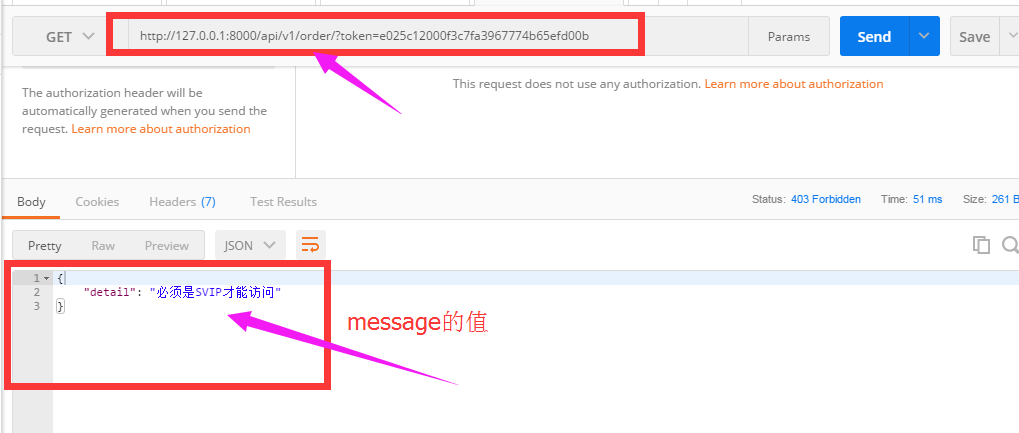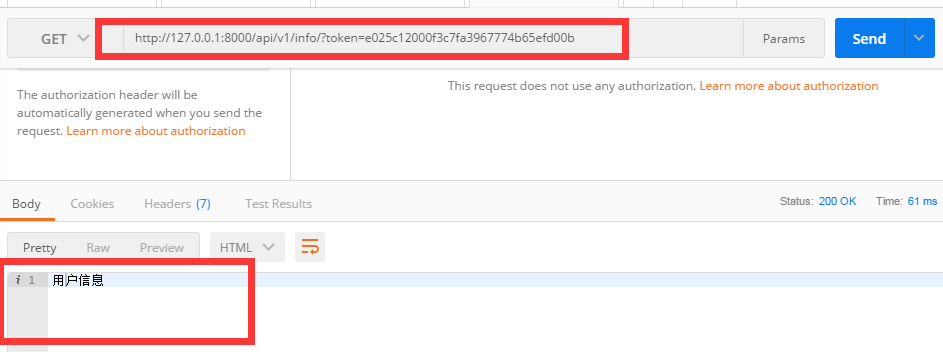Restful framework【第七篇】权限组件
基本使用
-写一个类:
class MyPer(BasePermission):
message='您没有权限'
def has_permission(self, request, view):
# 取出当前登录用户
user = request.user
# 取出当前登录用户类型的中文
tt = user.get_user_type_display()
if user.user_type == 0:
return True
else:
return False
-局部使用
permission_classes=[MyPer]
-全局使用
在setting中
"DEFAULT_PERMISSION_CLASSES":['app01.auth.MyPer'],
添加权限
(1)API/utils文件夹下新建premission.py文件,代码如下:
- message是当没有权限时,提示的信息
# utils/permission.py class SVIPPremission(object):
message = "必须是SVIP才能访问"
def has_permission(self,request,view):
if request.user.user_type != 3:
return False
return True class MyPremission(object):
def has_permission(self,request,view):
if request.user.user_type == 3:
return False
return True
(2)settings.py全局配置权限
#全局
REST_FRAMEWORK = {
"DEFAULT_AUTHENTICATION_CLASSES":['API.utils.auth.Authentication',],
"DEFAULT_PERMISSION_CLASSES":['API.utils.permission.SVIPPremission'],
}
(3)views.py添加权限
- 默认所有的业务都需要SVIP权限才能访问
- OrderView类里面没写表示使用全局配置的SVIPPremission
- UserInfoView类,因为是普通用户和VIP用户可以访问,不使用全局的,要想局部使用的话,里面就写上自己的权限类
- permission_classes = [MyPremission,] #局部使用权限方法
from django.shortcuts import render,HttpResponse
from django.http import JsonResponse
from rest_framework.views import APIView
from API import models
from rest_framework.request import Request
from rest_framework import exceptions
from rest_framework.authentication import BaseAuthentication
from API.utils.permission import SVIPPremission,MyPremission ORDER_DICT = {
1:{
'name':'apple',
'price':15
},
2:{
'name':'dog',
'price':100
}
} def md5(user):
import hashlib
import time
#当前时间,相当于生成一个随机的字符串
ctime = str(time.time())
m = hashlib.md5(bytes(user,encoding='utf-8'))
m.update(bytes(ctime,encoding='utf-8'))
return m.hexdigest() class AuthView(APIView):
'''用于用户登录验证''' authentication_classes = [] #里面为空,代表不需要认证
permission_classes = [] #不里面为空,代表不需要权限
def post(self,request,*args,**kwargs):
ret = {'code':1000,'msg':None}
try:
user = request._request.POST.get('username')
pwd = request._request.POST.get('password')
obj = models.UserInfo.objects.filter(username=user,password=pwd).first()
if not obj:
ret['code'] = 1001
ret['msg'] = '用户名或密码错误'
#为用户创建token
token = md5(user)
#存在就更新,不存在就创建
models.UserToken.objects.update_or_create(user=obj,defaults={'token':token})
ret['token'] = token
except Exception as e:
ret['code'] = 1002
ret['msg'] = '请求异常'
return JsonResponse(ret) class OrderView(APIView):
'''
订单相关业务(只有SVIP用户才能看)
''' def get(self,request,*args,**kwargs):
self.dispatch
#request.user
#request.auth
ret = {'code':1000,'msg':None,'data':None}
try:
ret['data'] = ORDER_DICT
except Exception as e:
pass
return JsonResponse(ret) class UserInfoView(APIView):
'''
订单相关业务(普通用户和VIP用户可以看)
'''
permission_classes = [MyPremission,] #不用全局的权限配置的话,这里就要写自己的局部权限
def get(self,request,*args,**kwargs): print(request.user)
return HttpResponse('用户信息')
urls.py
from django.contrib import admin
from django.urls import path
from API.views import AuthView,OrderView,UserInfoView urlpatterns = [
path('admin/', admin.site.urls),
path('api/v1/auth/',AuthView.as_view()),
path('api/v1/order/',OrderView.as_view()),
path('api/v1/info/',UserInfoView.as_view()),
]
auth.py
# API/utils/auth/py from rest_framework import exceptions
from API import models
from rest_framework.authentication import BaseAuthentication class Authentication(BaseAuthentication):
'''用于用户登录验证'''
def authenticate(self,request):
token = request._request.GET.get('token')
token_obj = models.UserToken.objects.filter(token=token).first()
if not token_obj:
raise exceptions.AuthenticationFailed('用户认证失败')
#在rest framework内部会将这两个字段赋值给request,以供后续操作使用
return (token_obj.user,token_obj) def authenticate_header(self, request):
pass
(4)测试
普通用户访问OrderView,提示没有权限

普通用户访问UserInfoView,可以返回信息

权限源码流程
(1)dispatch
def dispatch(self, request, *args, **kwargs):
"""
`.dispatch()` is pretty much the same as Django's regular dispatch,
but with extra hooks for startup, finalize, and exception handling.
"""
self.args = args
self.kwargs = kwargs
#对原始request进行加工,丰富了一些功能
#Request(
# request,
# parsers=self.get_parsers(),
# authenticators=self.get_authenticators(),
# negotiator=self.get_content_negotiator(),
# parser_context=parser_context
# )
#request(原始request,[BasicAuthentications对象,])
#获取原生request,request._request
#获取认证类的对象,request.authticators
#1.封装request
request = self.initialize_request(request, *args, **kwargs)
self.request = request
self.headers = self.default_response_headers # deprecate? try:
#2.认证
self.initial(request, *args, **kwargs) # Get the appropriate handler method
if request.method.lower() in self.http_method_names:
handler = getattr(self, request.method.lower(),
self.http_method_not_allowed)
else:
handler = self.http_method_not_allowed response = handler(request, *args, **kwargs) except Exception as exc:
response = self.handle_exception(exc) self.response = self.finalize_response(request, response, *args, **kwargs)
return self.response
(2)initial
def initial(self, request, *args, **kwargs):
"""
Runs anything that needs to occur prior to calling the method handler.
"""
self.format_kwarg = self.get_format_suffix(**kwargs) # Perform content negotiation and store the accepted info on the request
neg = self.perform_content_negotiation(request)
request.accepted_renderer, request.accepted_media_type = neg # Determine the API version, if versioning is in use.
version, scheme = self.determine_version(request, *args, **kwargs)
request.version, request.versioning_scheme = version, scheme # Ensure that the incoming request is permitted
#4.实现认证
self.perform_authentication(request)
#5.权限判断
self.check_permissions(request)
self.check_throttles(request)
(3)check_permissions
里面有个has_permission这个就是我们自己写的权限判断
def check_permissions(self, request):
"""
Check if the request should be permitted.
Raises an appropriate exception if the request is not permitted.
"""
#[权限类的对象列表]
for permission in self.get_permissions():
if not permission.has_permission(request, self):
self.permission_denied(
request, message=getattr(permission, 'message', None)
)
(4)get_permissions
def get_permissions(self):
"""
Instantiates and returns the list of permissions that this view requires.
"""
return [permission() for permission in self.permission_classes]
(5)permission_classes

所以settings全局配置就如下
#全局
REST_FRAMEWORK = {
"DEFAULT_PERMISSION_CLASSES":['API.utils.permission.SVIPPremission'],
}
内置权限
django-rest-framework内置权限BasePermission
默认是没有限制权限
class BasePermission(object):
"""
A base class from which all permission classes should inherit.
""" def has_permission(self, request, view):
"""
Return `True` if permission is granted, `False` otherwise.
"""
return True def has_object_permission(self, request, view, obj):
"""
Return `True` if permission is granted, `False` otherwise.
"""
return True
我们自己写的权限类,应该去继承BasePermission,修改之前写的permission.py文件
# utils/permission.py from rest_framework.permissions import BasePermission class SVIPPremission(BasePermission):
message = "必须是SVIP才能访问"
def has_permission(self,request,view):
if request.user.user_type != 3:
return False
return True class MyPremission(BasePermission):
def has_permission(self,request,view):
if request.user.user_type == 3:
return False
return True
总结:
(1)使用
- 自己写的权限类:1.必须继承BasePermission类; 2.必须实现:has_permission方法
(2)返回值
- True 有权访问
- False 无权访问
(3)局部
- permission_classes = [MyPremission,]
(4)全局
REST_FRAMEWORK = {
#权限
"DEFAULT_PERMISSION_CLASSES":['API.utils.permission.SVIPPremission'],
}
Restful framework【第七篇】权限组件的更多相关文章
- Django-CRM项目学习(七)-权限组件的设置以及权限组件的应用
开始今日份整理 1.利用自定制标签,增加展示权限,权限分级设定 1.1 在权限组件中创建自定义标签 使用自定义标签的目的,使各个数据进行分离 1.2 导入自定义标签包 自定义标签复习(自定义标签有三种 ...
- Restful framework【第一篇】RESTful 规范
什么是RESTful REST与技术无关,代表的是一种软件架构风格,REST是Representational State Transfer的简称,中文翻译为“表征状态转移” REST从资源的角度类审 ...
- Restful framework【第二篇】APIView
安装djangorestframework 方式一:pip3 install djangorestframework 方式二:pycharm图形化界面安装 方式三:pycharm命令行下安装(装在当前 ...
- Entity Framework 第七篇 简化排序
上篇介绍了EF的分页实现,分页的时候会用到排序,但是使用起来表达式写的似乎很繁琐 , ); 如果直接使用排序字符串,不更直观简便么? respository.GetPaged<S_Users&g ...
- Restful framework【第九篇】分页器
基本使用 分页 -简单分页 page_size = api_settings.PAGE_SIZE :每页显示条数 page_query_param = 'page' :查询的页码数 page_size ...
- CRM第一篇:权限组件之权限控制
一.权限组件(1):一级菜单 二.权限组件(2):二级菜单 三.权限组件(3):默认选中非菜单(二级菜单) 四.权限组件(4):给动态菜单增加面包屑导航 五.权限组件(5):权限粒度控制到按钮 六.权 ...
- Django高级篇三。restful的解析器,认证组件,权限组件
一.rest=framework之解析器 1)解析器作用. 根据提交的数据.只解析某些特定的数据.非法数据不接收,为了系统安全问题 比如解析的数据格式有 有application/json,x-www ...
- restful framework之权限组件
一.权限简介 只用超级用户才能访问指定的数据,普通用户不能访问,所以就要有权限组件对其限制 二.局部使用 from rest_framework.permissions import BasePerm ...
- Django REST framework —— 权限组件源码分析
在上一篇文章中我们已经分析了认证组件源码,我们再来看看权限组件的源码,权限组件相对容易,因为只需要返回True 和False即可 代码 class ShoppingCarView(ViewSetMix ...
- drf:restful概念,类继承关系,drf请求封装,drf请求流程,版本控制组件,认证组件(token),权限组件
1.restful规范 resfful规范的概念最重要: 是一套规范,规则,用于程序之间进行数据交换的约定. 他规定了一些协议,对我们感受最直接的就是,以前写增删改查的时候需要些四个视图寒素,rest ...
随机推荐
- Git-什么是分支
为了理解什么是分支,我们先要回顾Git是如何存储数据的. Git并不会保存文件的差异值或者说变化量,而是直接保存文件的快照. 在Git中提交时,会保存一个commit对象,该对象包含一个指向暂存内容快 ...
- html5-嵌入图片
<!DOCTYPE html><html lang="en"><head> <meta charset="UTF-8&qu ...
- 获取数据库连接对象Connection
2018-11-04 19:50:52 开始写 public Connection getConn() {//返回类型为Connection try { Class.forName("co ...
- jQuery事件--blur()和focus()
blur([[data],fn]) 概述 当元素失去焦点时触发 blur 事件. 这个函数会调用执行绑定到blur事件的所有函数,包括浏览器的默认行为.可以通过返回false来防止触发浏览器的默 ...
- 计算属性(computed)、方法(methods)和侦听属性(watch)的区别与使用场景
1,computed 能实现的,methods 肯定也能够实现. 2,不同之处在于,computed 是基于他的依赖进行缓存的,computed 只有在他的的相关依赖发生改变的时候才会重新计算. 如果 ...
- Spring 默认的 AopProxy
Spring 默认的 AopProxy JdkDynamicAopProxy Spring xml 文件默认解析器 DefaultDocumentLoader 采用 standard JAXP-con ...
- new sh file
创建新文件 sbash='#!/bin/bash' sauth='# auth: xiluhua' sdate="# date: $(date +%Y-%m-%d)" shead= ...
- js异步计时器
js中同步和异步的区别: 1.同步会阻塞代码执行,而异步不会 2.alert 是同步,setTimeout 是异步 何时需要异步 1.在可能发生等待的情况 2.等待过程中不能像 alert 一样阻塞程 ...
- java == 与 equals 相同与不同点
java中与很多有意思又值得深究的点. 写这篇文章呢,是由于在百度知道中看到一个问题:怎样比较两个对象是否相同.这又使我想到了另外一个问题,== 和 equals有什么不同?写了几行代码,看了几篇文章 ...
- CAT Caterpillar ET is really a exceptional obd2 solution
As a excellent obd2 solutions,Heavy Duty Diagnostic CAT Caterpillar ET Diagnostic Adapter features a ...
